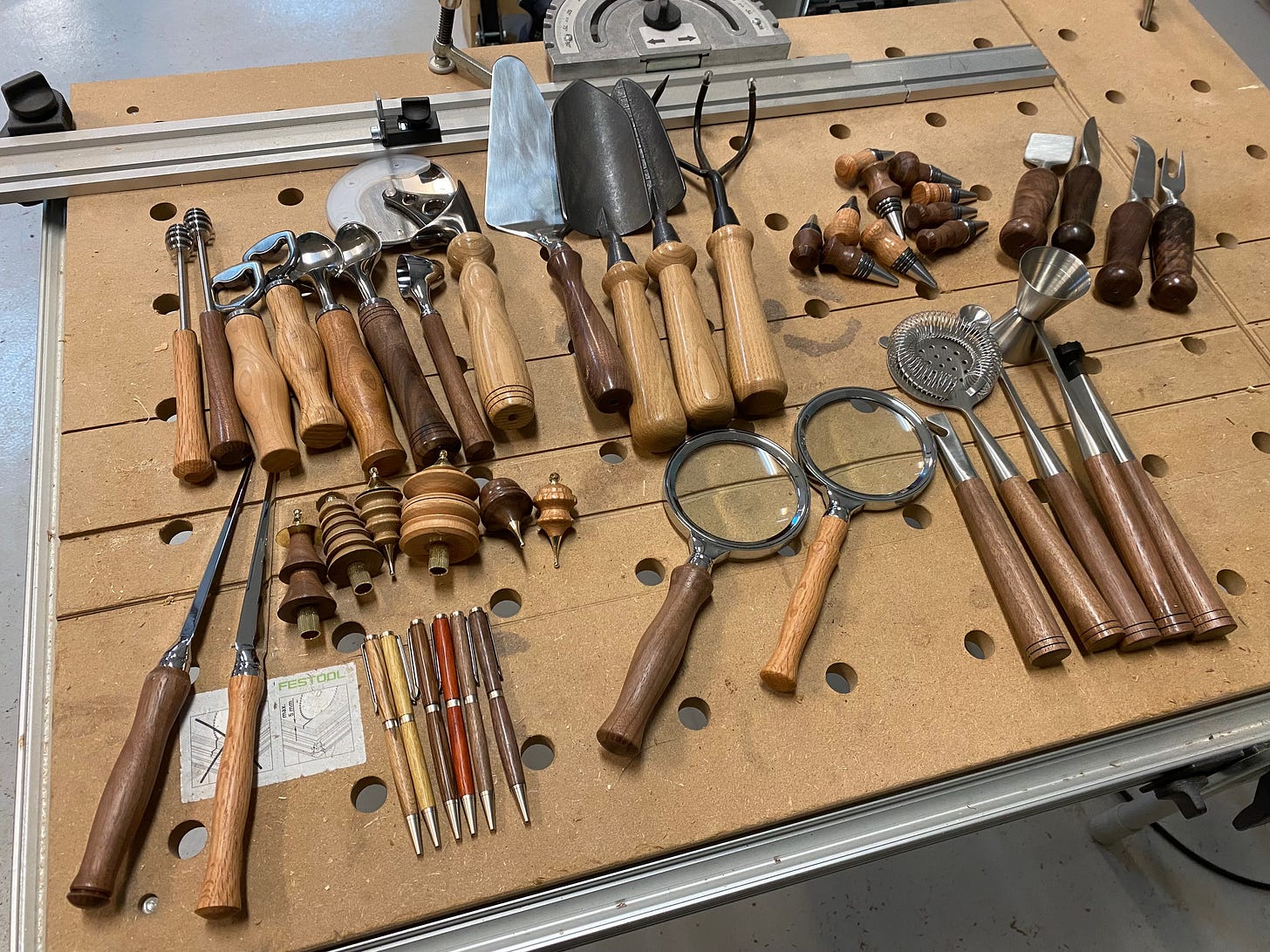I’m late to the lathe. Wood turning wasn’t ever something that interested me, though I hadn’t really been exposed to it, either. It also scared me, a bit; moreso than other shop tools. I mean yeah, a table saw blade can take a finger faster than a blink of an eye, but it’s predictable. Spinning chunks of wood, though? That seemed a far more likely danger to one’s hands, face and torso.
Nevertheless, I bought a lathe off a retiring woodworker who was emptying his shop. I was there to buy other items, but the price he was asking for it and his turning tools was low enough that I figured, why not?
A few months went by and I hadn’t fired it up. I guess I was still a bit apprehensive driven by the fact that nobody had ever shown me how to use a lathe or what could go wrong and how to avoid catastrophe. It was the fact that I didn’t know anything, including what I didn’t know, that had me concerned.
Then I saw a local woodworking shop advertising an in-store lathe demo. I figured that was my chance to learn at least some of what I needed to know. It did just that. The demonstrator provided safety tips (always rotate the piece by hand before turning on the machine), best practices (how to hold the gouges and skews), and walked us through making a few different items, including a pen and a bowl.
The demo gave me the confidence to give it a whirl. A twirl. A turn. A try.
I started with pens, using kits that I bought from the store showcasing the demo (I guess it worked). I cut my small walnut pen blanks (¾”x3/4”x3”) from scrap walnut and drilled 7mm holes through the centers of them.


Next, I glued brass tubes into the holes and mounted the blanks onto a mandrel — essentially a rod that the pen sits on. Once everything was tight, I turned on the lathe and started making chips fly.
Wearing a face shield, I pressed the gouge into the wood. I was expecting the wood to violently shake my hand, but instead I felt and heard a mere chit-chit-chit-chit as the wood blank’s corners met my metal gouge. After a few seconds, the chits fell away and a smooth zhzhzh rose from the wood. I had turned the rectangle to a column.
Mounted on the mandrel to each side of the blanks are guide bushings to mark the intended thickness of the blank. Matching the profile of the bushing should make the blanks fit the kit perfectly, I so kept pushing the gouge into the wood until it was flush with the bushing, which I could feel with my finger.
Once I was satisfied with how I cut the blanks, I grabbed some sandpaper and held it against the wood. As it turned, dust flew off, the air filled with the tart, earthy odor of walnut, and the wood smoothed. I did this through successive grits and wished all sanding was this easy. I also made a mental note to always wear an N95 mask when sanding. All that dust can’t be good for the lungs. (In fact, the previous owner had lung cancer. I sure hope the lathe wasn’t to blame.)
To finish the raw wood, I applied some high-friction polish with a rag. The dullness of the wood suddenly sprang rich and vibrant. I took the finished pieces from the lathe. and followed the kit’s instructions to assemble the completed pen.
Making pens was more fun than I imagined and a great way to complete a nice project in a short amount of time using (oftentimes) scrap wood from other projects. After watching a few YouTube videos, I see super creative ways people are preparing pen blanks and the incredible results you can get:
In fact, I became such a fan of the lathe, I built a new workstation for it (more on that next time) and found myself adding new accessories, like an upgraded tailstock (sort of like a horizontal top that provides lateral support to the wood), a mounting chuck, and a drill chuck.
My God, hobbies are just lame excuses to spend money, aren’t they?
And a pen centering press.
🙄
And a new pen mandrel.
😒
I turned more than 70 pieces these past few months — mostly pens and handles for various tools and utensils, plus a few Christmas ornaments and wine stoppers.
Handles, for things like bottle openers, garden tools, bar tools, ice cream scoops, are made slightly differently than pens. The blanks are much larger, of course, but also they mount differently, either in the vice of a chuck or via a threaded insert that’s been screwed into the blank.



I find two challenges when making handles: Avoiding making them look too phallic. I find this to be more challenging than I should. What that says about me, I’ll leave to others. Second, and I don’t think this is related, making sure the handles are comfortable to hold.
And maybe a third — making handles that don’t all look the same, unless it’s part of a set, in which case they should look very much the same, which was a fourth difficulty!
In the end, I think I mostly navigated all four challenges and produced a wide array of gifts. I actually need to make some more to have in our own home!

Aside from the enjoyment I get from making these, the quality of the hardware you get in the kits is really fantastic — heavy and obviously high-quality.
I’m already looking forward to making more of these kits — some for ourselves and some as gifts — but I also want to try some other things. In particular, I’d like to try turning bowls. I guess I just need to keep my eyes peeled for the right chunk of wood.



